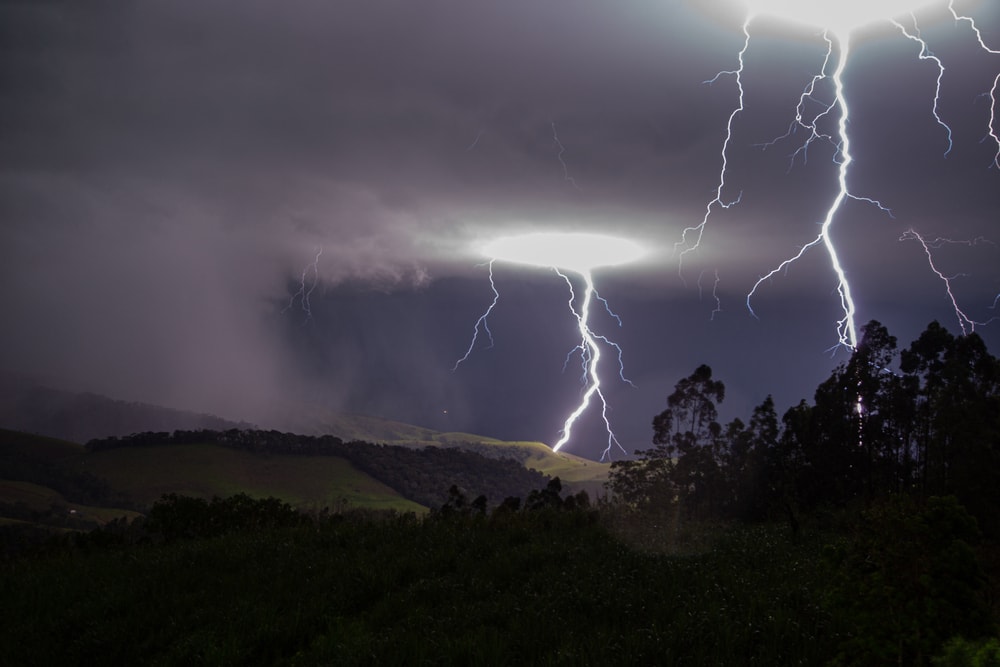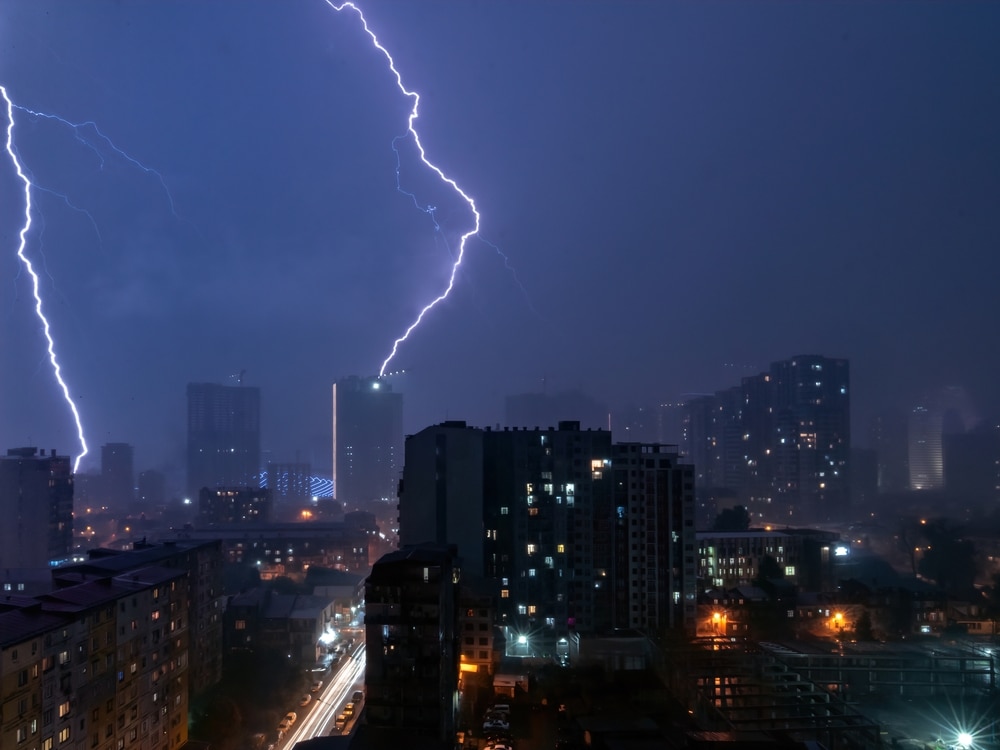Outforia Quicktake: Key Takeaways
- The odds of being struck by lightning in one’s lifetime are 1 in 15,300, with the odds in any given year being less than 1 in a million.
- Lightning is an electrostatic discharge created by liquid water drops and ice crystals colliding in a cloud.
- Positive lightning strikes are less common but more dangerous than negative strikes, with the potential to be 10 times greater in strength.
- Lightning occurs most frequently in the US state of Florida, with southeastern states generally experiencing more lightning than northwestern states.
- Venezuela is the lightning capital of the world, with over 1.5 million lightning strikes occurring each year over Lake Maracaibo.
The chances of getting struck by lightning are 1 in 1,222,000. The odds can change depending on your surroundings and where you live. You can find out which countries and states have the most lightning strikes later on!
What Are the Odds of Getting Struck By Lightning?

More than 3 million lightning flashes occur each day around the world. This averages to be about 44 lightning flashes per second.
About 40 million of these lightning strikes occur in the US every year.
The odds of getting struck by lightning in any given year is less than 1 in a million. Not to worry, however, as the odds of being struck by lightning in one’s lifetime is 1 in 15,300.
What is Lightning?

Lightning is an electrostatic discharge created by liquid water drops and ice crystals bumping together.
Small and large ice crystals and liquid water drops collide when an updraft mixes the air around in a cloud. These collisions create negatively charged particles called electrons. The positive (protons) and negative charges inside the cloud begin to move apart.
Electrons sink to the bottom layer of the cloud. Protons rise to the top layer. The charges begin to pull on each other and the negative charge expands.
Once the charge is strong enough, it forms a stepped leader. This is a channel of negatively charged particles that shoots down to the Earth’s surface. What happens next is what we perceive as lightning.
The return stroke is the lightning bolt we can see with our eyes. This process happens extremely fast. So, we’re not actually seeing the stream of lightning coming down to Earth as a stepped leader. We’re seeing it as the return stroke that bounces back to the sky.
It only takes a few thousandths of a second for this phenomenon to occur. We’re unable to see the initial stepped leader because it happens so fast.
Types of Lightning

Most lightning strikes are negatively charged, known as negative lightning. This type of lightning forms in the negatively charged bottom base of a thundercloud.
Positively charged lightning strikes are less common. They only account for less than 5% of all lightning strikes. Positive lightning strikes are more dangerous than negative strikes.
Positive lightning is created in the positively charged area in the upper-level of a cumulonimbus cloud.
The stepped leader that forms has a positive charge rather than negative. When its charge levels are peaked, positive lightning has the ability to be 10 times greater than negative lightning. It can have an electrical current as strong as 300,000 amperes and 1 billion volts.
Forest fires and power line damages are more likely to occur when positive lightning strikes.
Lightning can come in multiple forms, including:
- Cloud flashes
- Cloud-to-ground (CG)
- Cloud-to-cloud (CC)
- Heat lightning
- Bolt from the blue
Cloud flashes don’t reach the ground. They stay within or around the thundercloud. Lightning that stays within the cloud is called intra-cloud (IC) flashes. Lightning that doesn’t touch the ground but extends outward from the cloud is called cloud-to-air (CA) flashes.
Cloud-to-ground flashes are negative lightning strikes that reach the ground.
Cloud-to-cloud flashes occur when lightning forms in one cloud and travels to another.
When a storm is too far away for you to hear thunder, you may see heat lightning. This lightning isn’t close enough yet to hear thunder. However, lightning can still be dangerous from long distances.
Bolt from the blue is a type of positive lightning that can travel sideways for miles and still strike the ground. This phenomenon can catch people by surprise because the lightning bolt can be carried to a place experiencing fair weather.
You may also like: Identifying The 10 Types Of Clouds: Pictures & Chart (+ 14 Seldom Ones)
Where Does Lightning Occur?

Lightning occurs in all regions in the United States. Some states experience lightning strikes more often than others. Southeastern states usually see more lightning than northwestern states.
In the US, lightning occurs most frequently in the state of Florida. Orangetree, FL has the highest lightning strike frequency in the state. More than 30 deaths have resulted from lightning strikes in Florida between 2006 and 2021.
Texas has also had more than 30 deaths by lightning strikes between 2006 and 2021. Other states that follow include:
- North Carolina
- Georgia
- Alabama
- Missouri
- Colorado
- Arizona
Subtropical regions are prone to thunderstorms and lightning strikes. Lake Como in northern Italy experiences the most lightning strikes in Europe.
The five continents where lightning strikes are most frequent are the following:
- South America
- North America
- Africa
- Asia
- Oceania
Venezuela in South America is the lightning capital of the world. It has the highest frequency of lightning strikes than any other place on Earth. They mostly occur around Lake Maracaibo. This area is situated between two mountains within the Andes.
There are several factors that cause the air in this region to become unstable. The Caribbean Sea to the north brings in warmer temperatures and moisture.
Winds passing over the tops of the two mountain ranges meet each other over the lake. All of this creates likely conditions for updraft development. Updraft is when warm air begins to rise and develop into a thundercloud.
Over 1.5 million lightning strikes occur each year over Lake Maracaibo. Other regions may experience more lightning strikes in any given year if the conditions are right. But Venezuela holds first place for the average number of lightning strikes every year.
Other top countries that experience the most lightning strikes from each continent include:
- Democratic Republic of Congo, Africa
- Guatemala, North America
- Pakistan, Asia
- Northern Australian coast, Oceania
Hot and humid weather creates likely conditions for thunderstorms. These weather conditions are most common in tropical and subtropical regions.
You may also like: A Spectrum Of Electrons: What Color Is Lightning?
When Does Lightning Occur?

Lightning occurs most often during the summer. There is more moisture and warmth in the air that can cause air instability when paired with other factors.
Although lightning is most common during the summer, it can also happen in the winter.
Air is more stable in the winter and doesn’t have as much moisture, so lightning isn’t a common occurrence. But if the conditions are right, thundersnow storms can create lightning. Warm fronts that create moisture and air instability can cause lightning in the winter.
Severe snowstorm lightning strikes have been observed over the Great Lakes during lake effect snow storms.
Thunder and snow storms aren’t the only ways lightning can occur. It can also occur during hurricanes, nuclear detonations, pyrocumulonimbus clouds created by forest fires, and volcanic eruptions.
You may also like: 24 Types Of Natural Disasters That You Need To Know
Lightning Fun Facts


Some people in the late 18th century believed church bells repelled lightning.
In the late 18th century, it was a common belief that church bells repelled lightning strikes. However, being in a bell tower is one of the most dangerous places a person could be during a storm.
Many church bells from the 18th century had the inscription fulgura frango. This inscription has a number of translations, but the overall meaning is “I repel the lightning” or “I break the lightning”.
The tradition of ringing church bells to ward off lightning ended when 103 bell ringers died from lightning between 1753 and 1786 in France.

Lightning heats up the surrounding air to searing temperatures.
Lightning has the ability to heat up surrounding air to temperatures up to 60,000 degrees Fahrenheit (33,316 degrees Celsius). For perspective, the sun has a surface temperature of about 10,000 degrees F (5,538 degrees C).

Lightning is only slightly wider than the average width of the index finger.
Our eyes perceive lightning wider than it actually is. A lightning bolt is only about 0.79 – 1.2 in (2-3 cm) wide. The average width of an adult’s index finger is 0.63 – 0.79 in (1.6-2 cm).
You may also like: 19 Incredible Types Of Storms
Lightning FAQs

How fast does lightning travel?
Lightning travels at about 260,000 mph (434,523 kph). But the flashes we see that come from a lightning strike are traveling at the speed of light.
Can lightning strike the same spot multiple times?
There’s a common misconception that lightning doesn’t strike the same place more than once. Lightning can strike the same place more than once. Objects that attract lightning, such as isolated objects, are likely to be struck more than once.
Can you hear static when a storm is approaching?
When lightning is very close, you may be able to hear static in the form of buzzing or humming. This is likely to happen if you’re outdoors and in harm’s way of lightning. If you hear buzzing as a storm approaches, you should get away from the area and seek shelter immediately.
Can thunder occur without lightning?
No, thunder doesn’t happen without lightning. If a storm is too far away, you may see lightning without hearing thunder. It’s impossible to have thunder without lightning because lightning creates thunder.









